When we talk about Great Beauty referring to the artistic and cultural heritage of our country, one of the first places that come to mind is certainly the Siena Cathedral.
I had already visited the Cathedral when I was a child with my parents, but many years had passed since then and I kept a rather faded memory of it.
This time, however, I had the opportunity to appreciate the works properly, with the awareness of what I was seeing and – a detail to keep in mind – dedicating the correct times to it.
We included the visit of Siena at the end of a week-long itinerant tour, during which we discovered the places of greatest interest in Val d’Orcia and Maremma.
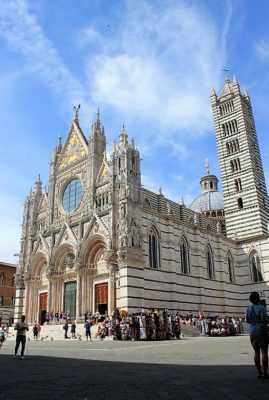
The Duomo
Since the city is a real open-air museum, during the planning phase of the trip the most complicated moment was to decide what to see in Siena in half a day.
After carefully evaluating the timing of the return trip, we chose to dedicate the time we had to visit the Cathedral.
Looking back at it, we can safely say that the choice turned out to be totally appropriate.
Adding other attractions in the tour in fact could have lead to put too much fish to fry and therefore seeing too many things and all too quickly.
At the end of our experience, we have prepared a small guide, with a whole series of information and useful tips to better organize the visit.
Table of Contents
- Siena, historical notes
- Where to park in Siena
- Siena Guided Tours
- Siena Cathedral, tips for the visit
- General info
- The Siena Cathedral Uncovered Floor
- Opening hours
- Tickets
- Siena Cathedral, what to see
Siena: historical notes
Although there is no certain information, probably the first inhabitants of the region where today’s Siena stands were the Etruscans.
After having suffered the Lombard and imperial dominations, during the twelfth century the city acquired its autonomy and began to rapidly grow under the economic, artistic and cultural aspect.
Siena was in fact geographically located in a strategic position along important trade routes and the Via Francigena.
The latter was the route that pilgrims took to reach Rome from Central Europe.
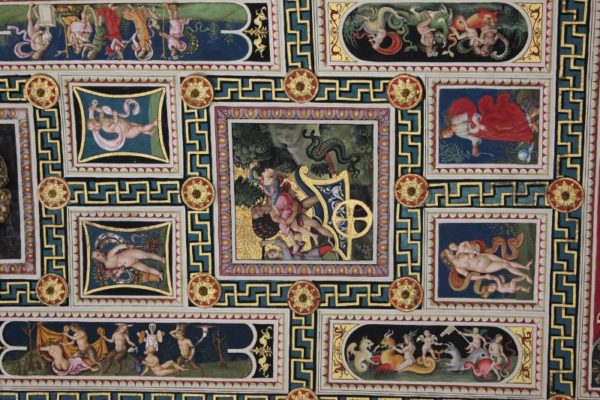
Detail of the Piccolomini Library ceiling
Its heyday lasted until the mid-fourteenth century, when the epidemic of bubonic plague that struck the continent exterminated over half of the population of the city in just three years.
Exhausted and agonizing, the city lost its independence in 1555 to Cosimo I de’ Medici, Duke of Florence.
In 1859 it was the first Italian city to vote in favor of annexation to the Kingdom of Italy.
Where to park in Siena
The historic center of Siena is spread over a rather small area, which is usually forbidden to traffic.
The Cathedral of Siena can therefore not be reached by own transport means.
For those arriving in Siena by car, motorbike or camper there are large paid parking areas available.
The ones closest to the Cathedral are those called Parcheggio Duomo and Parcheggio il Campo.
From both structures you can get to Piazza del Duomo with a pleasant walk of about ten minutes.
We parked the car, for practical reasons, in a multi-storey building located right in front of the train station.
Thanks to the escalator we popped out near Porta Camollia, contrada dell’Istrice, and from there we walked towards the center.
During our walk we passed in front of Palazzo Salimbeni, a beautiful historic building overlooking the homonymous square.
It is the headquarters of Monte dei Paschi di Siena, the famous Sienese banking institution.
Siena Guided Tours
If you are in Siena only for a few hours, then we personally recommend you to consider participating in a Guided Tour of Siena.
The meeting point is set in front of San Domenico Basilica and during the walk you will admire some of the most iconic places in the city: Palazzo Tolomei, Palazzo Salimbeni, Convent of Santa Caterina and Piazza del Campo.
The last stop includes a guided tour of the Duomo and the Baptistery.
The tour lasts about two hours and you will be accompanied by a qualified local guide who speaks English. French and Spanish speaking guides are also available.

The baptismal font in the Baptistery of San Giovanni
If you don’t have enough time for the Cathedral, you can opt for the shorter version of the Guided Walking Tour.
It lasts one hour and a half and it is the same as the above, just without the visit of the Cathedral.
If you stay in Florence instead, we suggest this one-day trip to Siena.
You will be directly pick-up at your hotel (if located in the Florence center) by an air-conditioned coach, and you will have the opportunity to visit the historic center of Siena, included its Cathedral (ticket not included).
In our opinion, the real added value of this experience lies in the evening experience: you will arrive in a typical wine estate in the middle of the Chianti region.
Here you will have a wonderful dinner with local products washed down by their fantastic selection of wines.
Siena Cathedral, tips for the visit
Based on our experience, hereafter you will find a whole series of practical information and useful tips to better organize the visit.
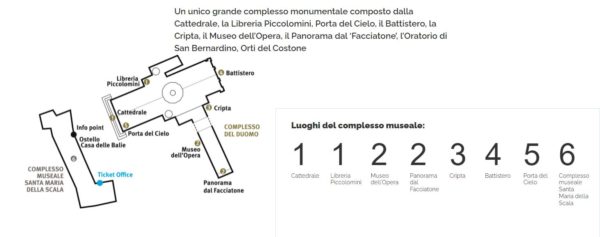
The map of the museum complex (© Opera della Metropolitana)
General info
The Opera della Metropolitana (OPA, from now on) is a non-profit vestry board that deals with protecting and promoting the complex of the Siena Cathedral.
On the website of this institution you will find all the information you need to organize the visit, including opening hours, the purchase of tickets and detailed information on the various structures that make up the museum complex.
The Siena Cathedral uncovered floor – 2025
What we consider one of the most beautiful works of the Duomo, until a few years ago was completely uncovered only on solemn festivities.
For conservation and protection needs.
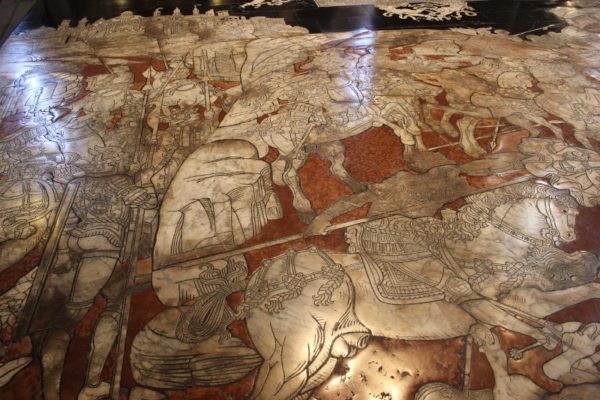
A detail of the Floor
In recent years, however, to meet the growing demand for visits by tourists and even locals, the OPA has decided to uncover the floor of the Duomo from the last Saturday of June.
This year the floor will remain uncovered until October 17, except for a brief interruption in the first half of August.
Here are the periods:
From 27th June to 31st July;
From August 18th to October 15th.
Opening hours
(Until March 6th January 2026)
Last entrance 30 min. before closing time.
Until 2nd November
Monday to Saturday from 10:00 to 19:00;
holidays from 13:30 to 18:00 (only Cathedral, the rest of complex follows weekday time);
From 4th November to 24th December
Monday to Saturday from 10:30 to 17:00;
holidays from 13:30 to 17:30 (only Cathedral, the rest of complex follows weekday time);
From 26th December to 6th January 2026
Monday to Saturday from 10:00 to 19:00;
holidays from 13:30 to 18:00 (only Cathedral, the rest of complex follows weekday time);
Period of uncovering of the floor (also Gate of Heaven)
From 27th June to 31st July and from 18th August to 15th October.
Monday to Saturday from 10:00 to 19:00;
holidays from 9:30 to 18:00;
Gate of Heaven
From 1st March to 6th January 2026.
The same time as the Cathedral.
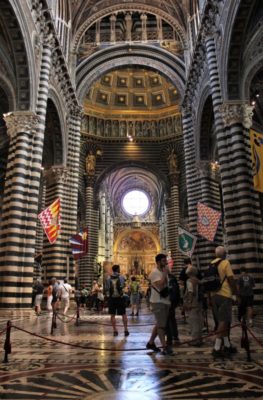
The central nave
Siena Cathedral Tickets
We have purchased an OPA SI pass online. It is a single ticket that allows you to save a few euros and offers the possibility to access to:
- Cathedral;
- Piccolomini Library;
- Opera del Duomo Museum;
- Facciatone;
- Crypt;
- Baptistery of San Giovanni.
The ticket does not include the Gate of Heaven path. In case you want to include it in the visit then a so-called “All Inclusive” ticket is available.
For specific categories (for example children up to 6 years, disabled with accompanying person, religious, etc.) the entrance to the Cathedral is free.
Siena Cathedral, what to see
The Cathedral of Siena is one of the most important examples of Roman-Gothic architecture in our country.
According to some historical evidence, in this place stood a church dedicated to the Assumption already in the ninth century.
Later a larger building was built, consecrated in 1179 by Pope Alexander III.
Starting from the second decade of the thirteenth century, the building was gradually rebuilt and expanded, based on a design by Nicola Pisano.
The works lasted for about two hundred years.
The beautiful façade is the work of Giovanni Pisano.
It consists of three pointed portals adorned with copies of numerous statues (the originals are in the Museo dell’Opera).
The upper area is of flowery Gothic style, with a large central rose window.
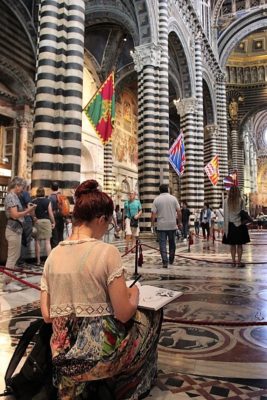
The interior of the Cathedral
The interior
The interior, Latin cross-shaped, consists of three large naves, embellished by the chiaroscuro effect of the black and white bands of the pillars.
Past the front door, you will be struck by so much beauty.
The Floor
The floor is probably the most fascinating work of the complex and was built between the fourteenth and nineteenth centuries.
It is divided into fifty-six marble panels and was realized with a derivation of the mosaic technique called a sezioni (in sections).
The preparatory cartoons of the fifty-six inlays were all made by artists of Sienese origin, except for one (the Monte di Sapienza one), prepared by the Umbrian painter Bernardino di Betto, called Pinturicchio.
In the panels are represented both sacred and profane scenes.
We were guided by the audio guides rented at the entrance, in our opinion indispensable to learn in detail the meaning of the works.
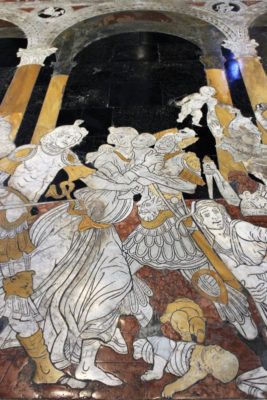
Detail of the floor
The Piccolomini Library
Crossing the entrance threshold, you will be literally amazed.
The library was built starting in 1492 at the behest of Cardinal Francesco Todeschini Piccolomini, who later became Pope Pius III, to preserve books and volumes that belonged to his uncle Pius II.
The interior has walls enriched with frescoes illustrating Enea Piccolomini’s episodes of life (Pope Pius II of Pienza).
They are the work of Pinturicchio and his collaborators.
The beautiful, decorated vault presents a series of allegorical figures, mythological episodes and scenes of the pastoral life of Cardinal Piccolomini.
We focused on the scene that portrays the Canonization of St. Catherine of Siena.
We looked carefully at the figures of the young Raphael, the one wearing the red socks, and of Pinturicchio himself, the one with the red cap.
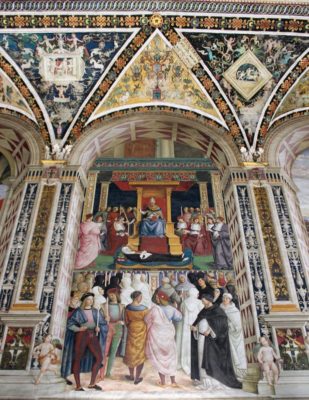
The canonization of St. Catherine of Siena
The Gate of Heaven path
It is a walking path created above the starry vaults, which offers splendid panoramic views, both inside and outside the Duomo.
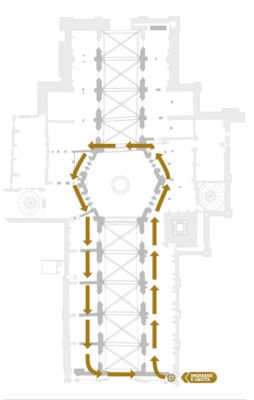
The map of the Gate to Heaven path (© Opera della Metropolitana)
The Baptistery and the Crypt
After a quick lunch in a tavern located near the complex, we moved to the back of the Cathedral.
Under the apse, overlooking Piazza San Giovanni, stands the Baptistery of San Giovanni.
The church has a Gothic façade, whereas the interior has a rectangular hall on two pillars.
The baptismal font, a masterpiece of the early Tuscan Renaissance, is hexagonal in shape and is located in the center of the Baptistery.
Some of the most important artists of the fifteenth century participated in the construction of the fountain: Jacopo della Quercia, Donatello and Lorenzo Ghirardi.
The Crypt, on the other hand, was discovered only in 1999.
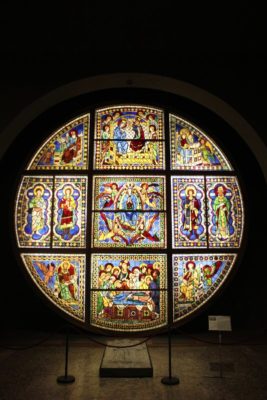
The stained-glass window, by Duccio di Buoninsegna
Opera del Duomo Museum
The Opera del Duomo Museum was set up in what should have been the right aisle of the Duomo Nuovo, a project aborted in 1357.
The main attractions are two works by Duccio di Buoninsegna: the Majesty and the stained-glass window that adorned the apse of the Duomo.
The Majesty is a masterpiece of Sienese painting, commissioned for the high altar of the Cathedral, of which it constituted the altarpiece until 1505.
Photo credits: the maps of the museum complex of the Siena Cathedral and the Gate of Heaven path have been downloaded from the website of the OPA.



0 Comments